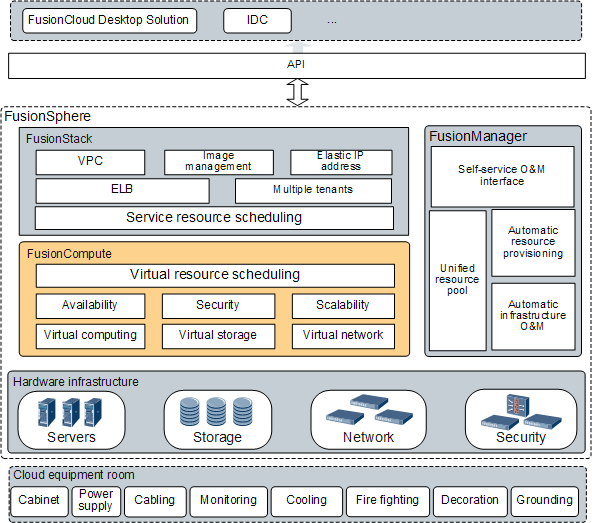FusionCompute virtualizes the resources of existing and newly-built physical IT infrastructures and manages virtual resources, service resources, and user resources in a centralized manner. It also implements various applications over unified interfaces. FusionCompute provides a logical view of all networks, computing, storage, and other resources, thereby allowing on-demand resource virtualization and scheduling using dynamic resource pools.
Unified Virtualization Platform: Implements Rapid Deployment
FusionCompute uses virtualization management software to divide and integrate computing, storage, and network resources into multiple resources units, which are used to create high-performance, operational, and manageable VMs.
Based on quality of service (QoS) policies, these VM resources can be allocated on demand. The VMs support a variety of OSs.
Large-Capacity Cluster: Supports Various Hardware Devices and Reduces Deployment and Maintenance Costs
In the FusionCompute system, a logical computing cluster supports a maximum of 128 physical hosts. The whole system supports a maximum of 3200 physical hosts, boasting the largest capacity in the industry. FusionCompute supports x86-based servers and mainstream storage devices, thereby providing enterprises and carriers with a wide range of hardware choices. It also supports centralized management for IT resource scheduling and power consumption, remarkably decreasing maintenance costs.
Automatic Inter-Domain Scheduling: Ensures QoS
FusionCompute supports inter-domain resource scheduling to implement centralized resource management over the whole network. FusionCompute also allows users to define service-level agreement (SLA) policies, fault reporting criteria, and fault rectification policies.
Rights- and Domain-based Management
- Based on different roles and domains, users are assigned with different rights. For example, a user of a branch organization in a certain region can be granted rights to manage only local resources.
Cross-Regional Resource Scheduling
- FusionCompute enables VM resources to be scheduled across regions over the layer 3 network by using the elastic IP address function.
- FusionCompute automatically detects the loads of servers or services and intelligently schedules resources to achieve load balancing across servers and service systems, ensuring better user experience and optimal system response time.
Comprehensive O&M management and Fine-Grained Charging
FusionCompute provides various operation and maintenance (O&M) tools to control and manage services, improving O&M efficiency. FusionCompute also supports fine-grained charging modes based on different service types.
- Black box for rapid fault locating
The black box provides logs and program heaps, which help carriers and enterprises to rapidly locate faults. This function facilitates fault location and rectification.
- Automatic health check
FusionCompute automatically detects system faults and generates alarms in real time.
- Web interfaces
FusionCompute provides web interfaces, which allow users to monitor and manage all hardware resources, virtual resources, and service provisioning using a web browser.
- Fine-grained charging
FusionCompute can implement charging for IT resources (CPUs, memory, and storage) based on usage or time.
Core Functions
| Parameter
|
Value
|
| Hosts supported by a VRM*
|
256
|
| Clusters supported by a VRM
|
32
|
| VMs supported by a VRM
|
5000
|
| Sites supported by a VRM domain
|
16
|
| Hosts supported by a cluster
|
128
|
| Administrators supported by the system
|
300
|
| VCPUs supported by a VM
|
64
|
| Virtual network interface cards (NICs) supported by a VM
|
8
|
| Disks supported by a VM
|
11
|
| Memory size supported by a VM
|
1 TB
|
| Disk capacity supported by a VM
|
64 TB
|
* A Virtualization Resource Management (VRM) is a management node in the FusionSphere system that manages resources in a host cluster and a logical cluster.

